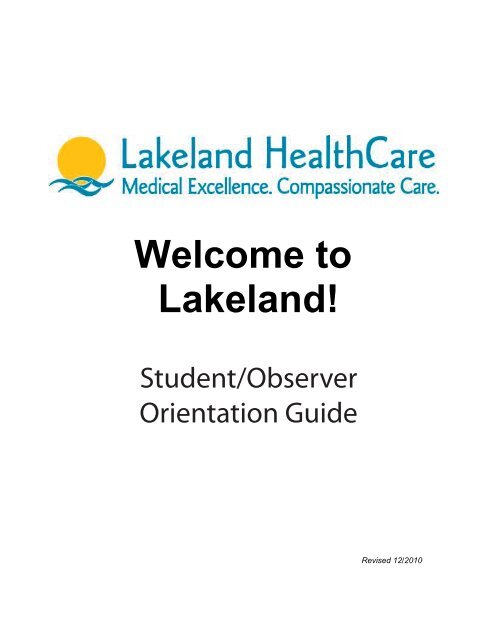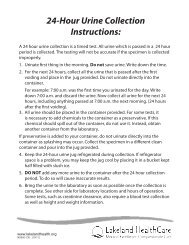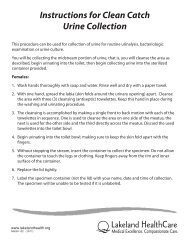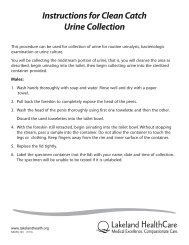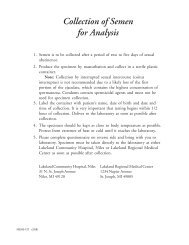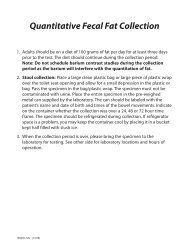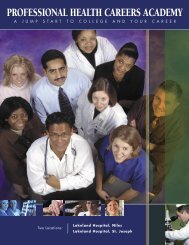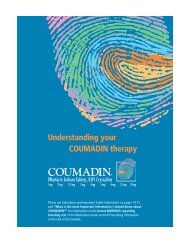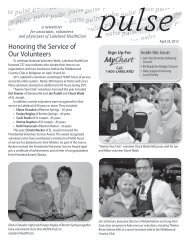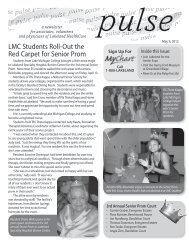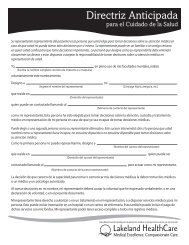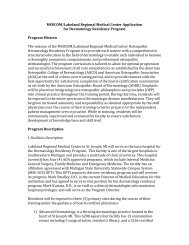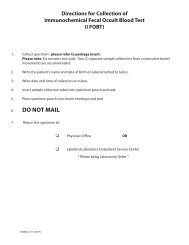Student Orientation Handbook - Lakeland HealthCare
Student Orientation Handbook - Lakeland HealthCare
Student Orientation Handbook - Lakeland HealthCare
You also want an ePaper? Increase the reach of your titles
YUMPU automatically turns print PDFs into web optimized ePapers that Google loves.
Welcome to<strong>Lakeland</strong>!<strong>Student</strong>/Observer<strong>Orientation</strong> GuideRevised 12/2010
About <strong>Lakeland</strong><strong>Lakeland</strong> <strong>HealthCare</strong> is a not-for-profit, community-owned healthsystem, which includes four hospitals, an outpatient surgery center,The Marie Yeager Cancer Center, rehabilitation services, homecare,hospice, laboratory services, diagnostic imaging, physicianpractices, and long-term care. The history of <strong>Lakeland</strong> dates backmore than a century, when our hospitals first began meeting theneeds of southwest Michigan residents. Today, we are proud tocontinue that tradition of service to our neighbors with excellent,compassionate care.Our People<strong>Lakeland</strong> has over 4,000 employees,who provide clinical and support servicesthroughout southwest Michigan.Commitmentto theCommunityA non-for-profit, community-ownedorganization, <strong>Lakeland</strong> <strong>HealthCare</strong> is governedby a board of directors made up of volunteersfrom southwest Michigan. The system reinvestsa substantial portion of its net income backinto the community in the form of new andupgraded facilities, subsidized care, free orlow-cost outreach, education and preventionprograms. In all, <strong>Lakeland</strong> returns millions ofdollars back to the community through itsprograms and direct support of patients. Thehospitals of <strong>Lakeland</strong> have always offeredessential health care services to everyone,regardless of their ability to pay. <strong>Lakeland</strong>continually works to create an integratedsystem of care that is accessible, affordable,compassionate, and responsible.ImportantPhone NumbersGeneral Information(800) 968-0115www.lakelandhealth.orgCenter for Outpatient Services, St. Joseph(269) 556-2800<strong>Lakeland</strong> Community Hospital, Niles(269) 683-5510<strong>Lakeland</strong> Community Hospital, Watervliet(269) 463-3111<strong>Lakeland</strong> Regional Medical Center, St. Joseph(269) 983-8300<strong>Lakeland</strong> Specialty Hospital, Berrien Center(269) 471-7761Margaret Beckley UptonCenter for Health Enhancement(866) 260-754424-hour Physician Referral Line(800) 303-8399Scheduling Line(866) 408-1311You can avoid potential wait times by schedulingan appoint ment for lab tests or diagnostic imaging.Ask your physician for more information.1
Mission and VisionThe <strong>Lakeland</strong> <strong>HealthCare</strong> MissionTo be the leader in high-quality, safe, patient-centered,compassionate, health-related services.expectthe BESTThe <strong>Lakeland</strong> <strong>HealthCare</strong> Vision<strong>Lakeland</strong> <strong>HealthCare</strong> and its staff will be the region’spreeminent providers of integrated health-relatedservices, recognized for exemplary patient experiences,clinical outcomes, safety and value.Our ValuesThe following values are extremely important tous in our pursuit to better serve our patients andthe community:★ TeamworkWe value TEAMWORK. We recognize thathighly effective and highly reliable teams arerequired to deliver exceptional patient care.We are committed to work collaborativelyand to recognize daily the contributions ofothers. We will freely and promptly shareinformation with those who need it fromus or from our department.★ RespectWe will treat others with RESPECT. We valuethe opinions, beliefs, and desires of those withwhom we work and those it is our privilege toserve. We are committed to appreciate and learnfrom the rich diversity within our workplaceand among our patients and their families.We will make it safe for others to speak up,disagree, share concerns, make suggestions,question decisions, admit mistakes or trynew ways to improve our care.★ AccountabilityWe will ensure ACCOUNTABILITY. We will takeresponsibility for all that happens in our area.We will not blame others but will work with ourteam to resolve any issue that stands in the wayof taking exemplary care of our patients and ofeach other. We will respectfully confront thosewho may not be living up to <strong>Lakeland</strong>’s mission andcore values regardless of their role or position. We willescalate any problems that we are unable to resolveto those best positioned to help.★ InspirationWe will work to be an INSPIRATION. We understandthat it is a privilege to be entrusted with the life andhealth of those we serve. We understand the differencebetween just showing up and being fully engaged.Each and every day, through our words and ouractions, we will strive to inspire those around usto be their best and to give their best.★ TrustWe will TRUST. We will behave in a way that earns andconveys the sense that we can rely on each other withconfidence. When we don’t fully understand the intentor decision of those around us we will first look for acharitable, rather than a critical, explanation. We willalways assume first the good intentions of others.We will behave, and ensure that others behave, in waysthat are always ethical and unquestionably honest.★ SafetyWe will focus on SAFETY. Each and every day we willremain focused on preventing harm to patients,visitors and associates. We will continuously watch for,and immediately intervene, when anyone may be atrisk for physical or emotional harm. Safety is our jobwherever we are and whatever we do. We will requireall those we encounter to understand and behave inways that are safe.2
Senior Leadership TeamLoren B. Hamel, MDPresident andChief Executive OfficerLinda Beushausen, RN,Chief Executive Officer, Hospice atHome; Vice President, Life Transitionsand Advance Healthcare PlanningTim CalhounVice President, Finance, andChief Financial OfficerRay CruseChief Executive Officer, <strong>Lakeland</strong>Community Hospital, Watervliet;Vice President, Strategy andBusiness InnovationLaurie Fleming, RNVice President, Outpatientand Diagnostic ServicesLowell Hamel, MDVice President, Medical Affairs;Chief Medical Officer;Co-Chief Quality OfficerDennis MackVice President, Operationsand Facility ManagementMary Ann Pater, JD, RNVice President, Legal Affairs/Risk Management;Chief Compliance OfficerNorma TiradoVice President, HumanResources and HealthInformation TechnologyWarren White, Jr.Vice President,<strong>Lakeland</strong> Physician PracticesEileen Willits, PhD, RNVice President, Patient CareServices; Chief Nurse Executive;Co-Chief Quality Officer3
History and BackgroundThe history of <strong>Lakeland</strong> <strong>HealthCare</strong> begins in 1899 with the inceptionof Mercy Hospital, located in Benton Harbor, Michigan. Since that time,we have experienced mergers, consolidations and growth, creating the<strong>Lakeland</strong> <strong>HealthCare</strong> system we know today.Center for Outpatient Services,St. JosephBelow is an overview of the growth of <strong>Lakeland</strong> <strong>HealthCare</strong>:1899 Mercy Hospital opens in Benton Harbor1951 Memorial Hospital opens in St. Joseph1977 Memorial Hospital (St. Joseph) and Mercy Hospital(Benton Harbor) merge1992 Pawating Hospital (Niles) merges with Mercy Memorial Hospital,forming <strong>Lakeland</strong> Regional Health System<strong>Lakeland</strong> Community Hospital,Niles1994 Berrien General Hospital merges with <strong>Lakeland</strong>2002 Center for Outpatient Services opens in Royalton Township,St. Joseph2009 Inpatient addition opens at <strong>Lakeland</strong> Regional MedicalCenter, St. Joseph<strong>Lakeland</strong> Community Hospital,Watervliet2010 Southwestern Medical Clinic becomes a<strong>Lakeland</strong> <strong>HealthCare</strong> AffiliateCommunity Hospital of Watervliet merges with <strong>Lakeland</strong>2011 The Marie Yeager Cancer Center in Royalton Township opensHospice at Home becomes a <strong>Lakeland</strong> <strong>HealthCare</strong> Affiliate2012 <strong>Lakeland</strong> Medical Suites, Niles opens to the public<strong>Lakeland</strong>’s history has created the financially strong institution it istoday. We are a not-for-profit, community-owned system of careserving southwest Michigan — Berrien, Cass and Van Buren counties.<strong>Lakeland</strong> Regional Medical Center,St. JosephOur system includes 473 physicians offering a wide range of specialties,397 acute-care beds, a heart center, a cancer care center, two outpatientdialysis centers, and orthopedic services including a total joint camp.In addition, our community benefits include services such as health,safety, wellness and prevention events and various instructional courses.We are proud of our growth and success, which has allowed us to offerour community the highest-quality health care available.<strong>Lakeland</strong> Specialty Hospital,Berrien Center4
Fast FactsRapid changes in our community and thedemand for our services continue to push<strong>Lakeland</strong> <strong>HealthCare</strong> to look ahead. Here are afew examples of how <strong>Lakeland</strong> continues toimprove and expand to better serve our patients.2011<strong>Lakeland</strong> <strong>HealthCare</strong> opened The Marie YeagerCancer Center at the <strong>Lakeland</strong> Health Parkin Royalton Township, St. Joseph. This new,30,000-square-foot medical facility includes ahighly qualifiedteam of cancerspecialists and asingle locationfor most cancerpatients’ needs, allin an environmentdesigned topromote healthand healing.The dedicated team of <strong>Lakeland</strong> CancerSpecialists grew as Sapna R. Patel, MD, joinedDrs. Edmund Paloyan and Gerald Kozuh. Thepractice also expanded services to the Niles area in2011. The physicians see patients two days a weekat <strong>Lakeland</strong> Community Hospital, Niles. <strong>Lakeland</strong>Cancer Specialists will relocate into the new<strong>Lakeland</strong> MedicalSuites, Niles whenit opens in earlysummer 2012.Constructionbegan for anexpansion of theemergency department at <strong>Lakeland</strong> CommunityHospital, Niles. The new unit will nearly doublethe size of the current facility with a total of 18rooms with 21 beds. Also, work began on <strong>Lakeland</strong>Medical Suites, Niles, a new medical office buildinglocated directly across the street from the Nileshospital. The 42,000-square-foot facility will housea dynamic group of expert physicians who willcome together to transform the delivery of qualityhealthcare in our community.Medical students from Michigan State University’sCollege of Osteopathic Medicine continue to trainat <strong>Lakeland</strong> <strong>HealthCare</strong>. The program includes84 weeks of clinical medical education. <strong>Student</strong>srotate through both the hospital and ambulatoryenvironments. Medical student education is thefoundation of <strong>Lakeland</strong>’s Graduate Medical Educationprogram, which includes Osteopathic residenciesin Emergency Medicine, Family Medicine, GeneralSurgery, and Internal Medicine.<strong>Lakeland</strong>’s electronic health record (EHR) system,known internally as ConnectCare, went live at24 of our affiliate physician offices in October 2011.Practices across the county include approximately500 physicians, medical providers, nurses, and supportstaff. The offices serve over 80 percent of residents inBerrien County, which has a population of more than160,000 people.<strong>Lakeland</strong>’s four hospitals and the Center for OutpatientServices, St. Joseph, went live with the systemFebruary 25, 2012. The EHR software, developed byEpic Systems, is used at some of our region’s largestand most prestigious healthcare institutions, includingthe University of Michigan, Ohio State UniversityMedical Center, and the Cleveland Clinic.In early October, workbegan on the $11.5million expansionand renovationof <strong>Lakeland</strong>Community Hospital,Watervliet. A total of10,000 square feet will be added to the hospital andwill include additions to the Emergency Department,5
Surgery, and all Inpatient Units. The EmergencyDepartment will comprise the largest portionof the facility’s expansion, growing by 6,500square feet at a cost of $4 million. The currenteight Emergency Department rooms, separatedby curtains, will be replaced by 10 private examrooms featuring sliding glass doors, telephones,and televisions. The new Emergency Departmentis expected to be completed in September 2012 aswell as additions to the second and third floors ofthe hospital. All other work will be completed byApril 2013.The Boards ofDirectors of<strong>Lakeland</strong> <strong>HealthCare</strong>and Hospice atHome approved alegal partnershipbetween the twoorganizations inlate November. Thenew organization is a wholly owned subsidiary of<strong>Lakeland</strong> <strong>HealthCare</strong> and is known as Hospice atHome, a <strong>Lakeland</strong> <strong>HealthCare</strong> Affiliate. As part ofthe integration agreement, strategic goals includeimplementing an integrated vision of hospicecare, increasing awareness among underservedcommunities, and expanding programs.2010<strong>Lakeland</strong> <strong>HealthCare</strong>and SouthwesternMedical Clinicaligned to form asingle organization toprovide health servicesin southwest Michigan.The partnershipenhances an alreadysuccessful connection that was forged more than40 years ago in 1968, when five physicians foundedSouthwestern Medical Clinic. The group’s commitmentto provide high-quality, compassionate care to patientsdovetailed perfectly with <strong>Lakeland</strong>’s own mission.The <strong>Lakeland</strong> Sleep Disorders and Treatment Centeropened a second location at <strong>Lakeland</strong> RegionalMedical Center, St. Joseph. The center is equippedto conduct up to three sleep studies simultaneously.It supplements the current sleep center at the Nileshospital, which received a technology upgrade. Bothlocations achieved accreditation with the AmericanAcademy of Sleep Medicine, demonstrating thehighest levels of care for the diagnosis andtreatment of sleep disorders.The Emergency Departments at the Niles and St.Joseph hospitals launched the Sexual Assault NurseExaminer (SANE) program. <strong>Lakeland</strong> CommunityHospital, Watervliet added the program in 2011. Theprogram is medically directed by a board-certifiedemergency medicine physician and staffed withregistered nurses who have undergone extensivemedical and legal training.6
Our Services• Cancer Care• Cardiovascular Care• Chest Pain Center• Children’s Services• Community Wellness• Critical Care Medicine• Diabetes Care• Diagnostic Imaging Services• Dialysis Services• Emergency Services• Health Education• Health Resource Libraries• Homecare• Home Medical Equipment• Hospice and Palliative Care• Hospital Doctors• HouseCalls• Interventional Radiology• Laboratory Services• Long-Term Acute Care• Long-Term Care• Maternal/Fetal Medicine• Maternity Services• Neurosciences• Neurotology• Nutrition Counseling• Occupational Therapy• Orthopedic Services• Otolaryngology• Pharmacy Services• Physical Therapy• Physician Practices• Podiatry• Psychiatry• Psychology• Senior Services• Sleep Disorders and Treatment Center• Speech Therapy• Sports Medicine & Orthopedic Rehabilitation• Stroke Center• Surgical Services, including da Vinci® robotic surgery• Weight Loss (Bariatric Surgery) Center• Wound Care (Hyperbaric Therapy) Center7
Board MembersMembersPatricia HallRetired - Dean,Lake Michigan CollegeOccupational StudiesGeorge Heenan, MDFamily Practice,Family Physicians ofSt. Joseph, PCStephen Hempel, MDCritical Care/Pulmonology2008 - 2010 Past Presidentof the Medical StaffJ. Douglas Huggett, DOCardiology, CardiologySouthwest, PCGeorge Kolettis, MDOrthopedic Surgeon,Southwest MichiganCenter for OrthopedicsMichael MortimoreDirector/Health Officer,Berrien CountyHealth DepartmentKenneth O’Neill, MDInternal Medicine,SouthwesternMedical ClinicMarcus Robinson, PhDPresident and CEO,Citizens forProgressive ChangeJeffrey Schmidt, DDSDentistLinda Stanley, MDRetired - FamilyMedicineWesley StephensRetiredThomas YeagerPresident,Printek, Inc.Judith ZachaOwner,Beacon Services, Inc.10
Medical Staff Officers2012 Officers and Members of theMedical Executive CommitteeJohn Froggatt III, MDPresident of theMedical StaffGlen Hastings, MDVice President of theMedical StaffDeborah Habenicht, MDSecretary/Treasurerof the Medical Staff2012 Medical Executive Committee MembersKeith VanOosterhout, MDChief of Staff at <strong>Lakeland</strong>Specialty Hospital,Berrien Center &Continuing Care CentersLowell Hamel, MDVice President ofMedical AffairsSherry O’Donnell, DOChief of MedicalDivisionW. Jay Sandor, MDChief of ProceduralDivisionDouglas Tacket, DOVice Chief of MedicalQuality, NilesMichael Wang, MDVice Chief of MedicalQuality, St. JosephMichael Schuhknecht, DOVice Chief of ProceduralQuality, NilesDilip Arora, MDVice Chief of ProceduralQuality, St. Joseph11
Medical DirectorsChristina Pareigis, MDAcute InpatientRehabilitationJames Sisamis, MDAnesthesiaMichael Schuhknecht, DOBariatric ServicesKourosh Baghelai, MDCardiothoracicSurgery ServicesKeith VanOosterhout, MDContinuing Care CentersMichelino Mancini, DOContinuingMedical EducationStephen Hempel, MDCritical Care/PulmonologyLynn Gray, MDDiversityBryan Staffin, DOEmergency ServicesGeorge Drake, MDHospiceNeil See, MDHomecare ServicesJohn Froggat III, MDHospitalist andInfection Control12
Medical DirectorsMichael Westfall, DOInformation ServicesKenneth O’Neill, MD<strong>Lakeland</strong> MedicalPracticesEdmund Paloyan, MDOncology ServicesChristopher Strayhorn, MDPalliative CareOpenPsychiatric ServicesPolya Samardar, MDRadiologyMark Smalley, DOResidency ProgramBenjamin Stockton, MDRoboticsInga Sriubiene, MDSleep LabRobert Ward, DOStroke ProgramKenneth Edwards, MDSurgical ServicesJose Gomez, MDWound Center13
Accreditations<strong>Lakeland</strong> has received a number of accreditationsnot only for the quality of care we provide, butalso for the quality of our employees. Theseaccreditations signify our commitment anddedication to providing the highest qualityof care to our patients.• American Academy of Sleep Medicine• American Association of Blood Banks• American College of Radiology• American College of Surgeons• American Hospital Association (AHA)• Clinical Laboratory Improvement Act (CLIA)• College of American Pathologists• Commission on Cancer of theAmerican College of Surgeons• Healthcare Quality Association onAccreditation• The Joint Commission• Mammography Quality Standards Act• Michigan Hospital Association (MHA)• Professional Services Board for theAmerican Speech and Hearing Association• Voluntary Hospitals of America (VHA)• Volunteer Health Professionals (VHP)14
Awards and Recognition<strong>Lakeland</strong> has been honored with many awardsthat illustrate our commitment to evidence-based,quality care for every patient we serve. Honors andawards include:• Designation as a Breast Imaging Centerof Excellence by the American College ofRadiology (Imaging Center at the Center forOutpatient Services, St. Joseph)• <strong>Lakeland</strong> Regional Medical Center, St. Josephand <strong>Lakeland</strong> Community Hospital, Niles wererecognized as Community Value Index Top100 hospitals and Community Value Five Star®hospitals by Cleverley + Associates in 2011• Named in top quintile of U.S. health systemsin 2011 and 2012 as ranked by ThomsonReuters based on eight performancemeasures including clinical quality, patientsatisfaction, and efficiency• Accreditation from the American Academyof Sleep Medicine• Accreditation as a Chest Pain Center withPCI from the Society of Chest Pain Centers(<strong>Lakeland</strong> Regional Medical Center,St. Joseph)• Five Star rating for Joint Replacement Careby HealthGrades in 2003 - 2011• 2011 Sustained Improvement Award from theU.S. Department of Health and HumanServices for achievements in the reduction ofhealthcare-associated infections• Outstanding Achievement Award from theCommission on Cancer• Granted a Three-Year Accreditation withCommendation by the Commission onCancer (CoC)• Recognition as a Blue Distinction Centerfor Cardiac Care by Blue Cross and BlueShield of Michigan• Gold Seal of Approval TM for Primary StrokeCenters from The Joint Commission• Silver-Plus Award for stroke care by theAmerican Heart Association and theAmerican Stroke Association• 2010 Consumer Choice Award from NationalResearch Corporation• 2010 Excellence in Customer Service Awardfrom Cornerstone Alliance for our dedicationto patient satisfaction• “3 Star” rating, the highest possible rating,from the Society of Thoracic Surgeons. Thisdesignation signifies excellence in cardiacsurgery outcomes, and is awarded to the top12% of programs nationwide• 2008 VHA Leadership Award for ClinicalExcellence for providing excellent care topatients in the intensive care unitDesignated as aCenter for Cardiac Careof Michigan15
Our Hospitals<strong>Lakeland</strong> Regional Medical Center,St. Joseph<strong>Lakeland</strong> Community Hospital,Niles<strong>Lakeland</strong> Community Hospital,Watervliet<strong>Lakeland</strong> Specialty Hospital,Berrien CenterMore than 40 locations throughout southwest Michigan, including:• 4 hospitals• 1 outpatient surgical center• 1 cancer center• 3 long-term care facilities• 9 homecare locations• 27 affiliate physician practice locations<strong>Lakeland</strong> Regional Medical Center, St. Joseph<strong>Lakeland</strong> Regional Medical Center, St. Joseph is a 254-bed hospitalproviding oncology, cardiology and cardiac surgery, neurosurgery,orthopedics, obstetrics, rehabilitation services, emergency care,behavioral medicine, invasive and non-invasive radiology and laboratoryservices. It is also the home of the Frederick S. Upton Education Centerand the Health Sciences Library.<strong>Lakeland</strong> Community Hospital, Niles<strong>Lakeland</strong> Community Hospital, Niles is an 89-bed hospital servingNiles and southwest Michigan with primary care and specialty care.Services include obstetrics, surgery, emergency care, radiology,outpatient oncology, laboratory, endoscopy, and Sleep Disordersand Treatment Center.<strong>Lakeland</strong> Community Hospital, WatervlietA 49-bed acute care facility, this hospital employs over 275 associatesand partners with 90 primary and specialty care physicians. Servicesinclude adult medical / surgical services, CT, diagnostic radiology,emergency services, EKG, inpatient acute rehabilitation, intensivecare services, laboratory services, mammography, mobile MRI,occupational therapy, pediatric services, physical therapy, surgicalservices, and ultrasound.<strong>Lakeland</strong> Specialty Hospital, Berrien CenterA 55-bed specialty hospital providing long-term/acute care, a specializedtype of care for patients whose conditions require a long hospital staywith a focus on management of complex medical care while providingphysical rehabilitation. Included are services to support this care,laboratory and radiology.16
Safety CodesCode Description Initial ResponseCode BlueCardiac ArrestCode OrangeBomb ThreatCode RedFireCode PinkInfant AbductionCode GreenMissing PatientCode YellowContaminated/Injured Patient(s)Code PurpleOB EmergencyCode SilverCriminal ActivityCode WestCode ThreeMajor or Minor DisasterDr. ArmstrongSecurity neededEvacuation in effectHazardous Materials Spill ORReleaseTornado WatchTornado WarningTo reduce the risk of collisionduring response to a cardiac arrestNotification of a bomb on campus,usually by an outside callerFire and/or smokeAn infant, toddler, or child ismissing or known to be kidnappedA patient is missingTo provide guidelines for thecare of contaminated/injuredpatient(s).Emergency in Obstetrics thatrequires immediate assistanceA person with a weapon and/ ora person who has taken hostages(including an active shooter).Uncontrolled person orviolent situationMultiple incoming casualtiesStaff person wished to havesecurity assistance withoutknowledge of patients and visitorsRemaining in area may behazardous to life, health, or safetySpill does not impact people ofsurrounding areaORMajor spill affectingsurrounding areaConditions are such that atornado may developA tornado has been sightedand may affect the hospitalTo initiate a code blue dial extension: 1111,Satellite facilities call 9-1-1Obtain as much information as possible,have another person call 9-1-1R-escue those in dangerA-ctivate manual alarmC-ontain the fireE-xtinguish the fireE-vacuate patientsSearch for anyone carrying items large enough to hold ababy, question anyone with young childrenMonitor outside doorsCharge nurse/designee in ER will verify by return call tothe sending facility.Response needed from Obstetrical or pediatric provider,anesthesiologist, RT, and house supervisorEvacuate if possible. Seek cover/protection and warnothers of the situation. Do not panic and stay alert.Call 9-1-1 and stay on line until police arrive.Call Security at 1111 to report occurrence in St. Joseph.Males not involved in patient care respond STAT toannounced locationMedical staff will be called in as directed by needCall 1111 and give location to operatorNotify all in area of need to evacuate. Evacuateambulatory, wheelchair, then bedridden.Isolate and secure the spill area, call MSDS at983-8311 for information on spill materialORIsolate the spill, evacuate the area,and contact securityCheck for essential equipment needed if weatherconditions proceed to a warningMove patients to safety, send nonessential staffand visitors to the basement17
List of FacilitiesBenton Harbor<strong>Lakeland</strong> at Meadowbrook, Benton Harbor~ <strong>Lakeland</strong> Care, Inc.~ <strong>Lakeland</strong> Health Foundation~ <strong>Lakeland</strong> Homecare Services~ <strong>Lakeland</strong> Homecare Solutions~ <strong>Lakeland</strong> Home Infusion Services~ <strong>Lakeland</strong> HouseCallsMercy Specialty Clinic at InterCareBerrien Center<strong>Lakeland</strong> Practice Solutions Business Office<strong>Lakeland</strong> Specialty Hospital, Berrien Center~ Long-Term Acute Care~ Continuing Care CenterBerrien Springs<strong>Lakeland</strong> Ear, Nose and Throat<strong>Lakeland</strong> Rehabilitation Services, Berrien SpringsSouthwestern Medical ClinicCounseling & Psychological ServicesBridgmanSouthwestern Medical ClinicFamily and Internal MedicineBuchananHospice at HomeColomaColoma Medical Center<strong>Lakeland</strong> Community Hospital, WatervlietOutpatient Rehabilitation CenterPaw Paw Lake Medical Center~ Family Care of Coloma-WatervlietHartfordStagg Medical CenterNiles<strong>Lakeland</strong> Community Hospital, Niles~ Buchanan Area Health Resource Library~ <strong>Lakeland</strong> Heart Center~ <strong>Lakeland</strong> Sleep Disorders and Treatment Center<strong>Lakeland</strong> Medical Suites, Niles~ Ambulatory Infusion Clinic, Niles~ <strong>Lakeland</strong> Cancer Specialists~ <strong>Lakeland</strong> Center for Wound Care and Hyperbaric Medicine~ <strong>Lakeland</strong> Comprehensive Weight Loss Center~ <strong>Lakeland</strong> Ear, Nose and Throat~ <strong>Lakeland</strong> General Surgery~ Lakeside Urology~ Southwestern Medical Clinic, Niles —Center for Women’s Health~ Van’s Medical Equipment of <strong>Lakeland</strong><strong>Lakeland</strong> Homecare, Niles<strong>Lakeland</strong> Rehabilitation Services, NilesLongmeadow Medical Suites, Niles~ <strong>Lakeland</strong> Family Medicine, Niles~ <strong>Lakeland</strong> Orthopaedics~ <strong>Lakeland</strong> Specialty Suites~ Liberty Dialysis at <strong>Lakeland</strong>, Niles~ Rehabilitation Services~ Sleep Medicine of <strong>Lakeland</strong>Maternal Infant Health Program NilesSouthwestern Medical ClinicAdult MedicineCounseling & Psychological ServicesPediatricsUrgent Care Walk-In ClinicSt. JosephCaretel Inns of <strong>Lakeland</strong>, St. Joseph<strong>Lakeland</strong> Continuing Care Center, St. Joseph<strong>Lakeland</strong> Regional Medical Center, St. Joseph~ The <strong>Lakeland</strong> Heart Center~ <strong>Lakeland</strong> Sleep Disorders and Treatment Center~ Van’s Medical Equipment of <strong>Lakeland</strong><strong>Lakeland</strong> Health Park, St. JosephCenter for Outpatient Services~ <strong>Lakeland</strong> Community Health Resource Library~ <strong>Lakeland</strong> Nutrition Counseling~ <strong>Lakeland</strong> Pharmacy Shoppe~ Lester C. Tiscornia Outpatient Surgery Center~ The Margaret Beckley UptonCenter for Health Enhancement~ Whirlpool Diagnostics and Imaging CenterHealth Park Medical Suites, St. Joseph~ <strong>Lakeland</strong> Hand Clinic~ <strong>Lakeland</strong> Neurosurgery~ <strong>Lakeland</strong> Orthopedic Physical Therapy~ <strong>Lakeland</strong> Rheumatology~ Neurosciences Institute~ Sleep Medicine of <strong>Lakeland</strong>~ Southwestern Medical Clinic, St. Joseph —Women’s Health CenterHospice at Home<strong>Lakeland</strong> Rehabilitation ServicesLakeside UrologyLiberty Dialysis at <strong>Lakeland</strong>Lory’s PlaceMarie Yeager Cancer Center~ <strong>Lakeland</strong> Cancer Specialists~ Van’s Health & Appearance CenterSouth HavenHospice at HomeStevensville<strong>Lakeland</strong> Rehabilitation Services, StevensvilleSouthwestern Medical ClinicAdult MedicinePediatricsUrgent Care Walk-In ClinicSouthwestern Medical ClinicCounseling & Psychological ServicesWatervliet<strong>Lakeland</strong> Community Hospital, Watervliet~ Acute Rehabilitation Unit~ After Hours Clinic~ Center for General Surgery~ Community Bone & Joint~ Community Medical Center~ Liberty Dialysis at <strong>Lakeland</strong>, Watervliet~ Specialty Clinic~ Watervliet Medical Center18
Service AreaFor additional details on the locations, please visit www.lakelandhealth.org19
Patient Centered CarePatient-Centered Care is organized around the needs and priorities of the patients and theirfamilies. Work is not driven by the tasks we do, but by the care we provide. At <strong>Lakeland</strong><strong>HealthCare</strong>, Patient-Centered Care is an important aspect of our culture.Patient-Centered Care Principles:ooooooooRelationships between patients, families, and caregivers are at the heart of care delivery.Informed caring is knowledge and skills.Everyone has a valuable contribution to make.A therapeutic relationship between the patient/family and a professional nurse is core toquality care.Healthy work relationships and environments result in high patient, staff, and physiciansatisfaction.People are most satisfied when their roles and daily work practices are in alignment withtheir personal and professional values.Empowerment and ownership of work and practice are essential elements of Patient-Centered Care.Transformational change happens one relationship at a time.Patient-Centered Care Behaviors:oooEffective communication is an opportunity to convey caring and compassion to our patientsand families. Often, the way information is communicated is as important as the informationitself. Providing clear, thorough explanations to patient questions can provide patients with asense of power and control over their care. When patients feel they are being listened to,they are more likely to be actively engaged in their health care.Being responsive to patient needs such as call lights, toileting needs, and painmanagement, can help reassure patients. Prompt response to patient needs sends apowerful message to patients who are dependent on caregivers and helps to decreasefeelings of powerlessness.A clean and quiet environment is reassuring to patients and creates a positive impression ofthe care they are receiving. If a patient’s expectations of a clean room and linens are notmet, the patient may question the quality of the care being provided. Patients also know theyneed to rest when healing. When a quiet and restful environment is not provided, patientsquestions the quality of care.16
Patient Bill of RightsAt <strong>Lakeland</strong>, we pledge to treat all of our patients fairly and in accordance with the following principles:Access to CareYou will not be denied appropriate care on the basis of race, religion, color, national origin, age, sex, sexualpreference, marital status, handicap, or source of payment.You are entitled to adequate and appropriate medical care and the right to expect reasonable continuity ofcare during your hospital stay, including help planning for your discharge.We will inform you if you need care or services that <strong>Lakeland</strong> is unable to provide. We will then provide youwith alternatives, including transfers to other care providers if that is necessary and medically advisable.You have the right to have your pain assessed, managed and controlled.Respect and DignityYou have the right to considerate, respectful care which recognizes your individuality and personal dignity.You are entitled to privacy, to the extent possible, in treatment and in caring for your personal needs.You may not be required to perform services for <strong>Lakeland</strong> unless it is for therapeutic purposes in the plan ofcare.Decision MakingYou and your family, where appropriate, have the right to be informed about and participate in decisionsregarding your care.You have the right to participate in ethical questions that arise during the course of your care, including issuesof conflict resolution, withholding resuscitative services, forgoing or withdrawal of life-sustaining treatment,and participation in investigational studies or clinical trials.You have the right to refuse treatment and to be informed of the consequences of refusal.Privacy and ConfidentialityYour medical care and treatment records will be kept strictly confidential and will only be used or disclosedas permitted by law. You may inspect or, for a fee, receive a copy of your records.You may request transfer to another room if the patient or visitors in your room are disturbing you.Any one not directly involved in your care must have your permission to be present.You may meet privately with your family and consult with a specialist, an attorney, or any other person ofyour choice. You have the right to access protective services and our care managers can assist you with this.17030-10C (10/10) (continued on
GrievancesYou are entitled to pursue your rights and may present grievances. You are entitled to information about<strong>Lakeland</strong>’s policies and procedures on how to start, review and resolve complaints.The Citizen’s Guide to Filing a Complaint Against a Health Care Facility is available in the lobbies of <strong>Lakeland</strong>hospitals.Personal SafetyYou have the right to expect security, personal privacy and confidentiality while being treated.Information and CommunicationIf you do not speak or understand English, we will provide you with an interpreter.You are entitled to send and receive mail, unopened, on the same day it is received at <strong>Lakeland</strong>. You maymake and receive telephone calls. Any restrictions on your ability to communicate will be made by your doctor,with your participation, and will be fully explained to you.You or your family, where appropriate, will be informed about the outcomes of care, including any unanticipatedoutcomes.You have the right to receive a full explanation of any proposed treatments or procedures including: potentialbenefits and drawbacks, potential problems related to recuperation, the likelihood of success, the possibleresults of non-treatment and any significant alternatives.18
2011 National Patient Safety GoalsGoal 1: Improve the accuracy of patient identificationUse at least two patient identifiers when providing care, treatment, and services.Eliminate transfusion errors related to patient misidentification.Goal 2: Improve the effectiveness of communication among caregiversReport critical results of tests and diagnostic procedures on a timely basis.Goal 3: Improve the safety of using medicationsLabel all medications, medication containers, and other solutions on and off the sterile field inperioperative and other procedural settings. Note: Medication containers include syringes,medicine cups, and basins.Reduce the likelihood of patient harm associated with the use of anticoagulant therapy.Goal 7: Reduce the risk of health-care associated infectionsComply with either the current Centers for Disease Control and Prevention (CDC) hand hygieneguidelines or the current World Health Organization (WHO) hand hygiene guidelines.Implement evidence-based practices to prevent health care–associated infections due tomultidrug-resistant organisms in acute care hospitals.Implement evidence-based practices to prevent central line–associated bloodstream infections.Implement evidence-based practices for preventing surgical site infections.Goal 8: Accurately and completely reconcile medications across the continuumof careA process exists for comparing the patient’s current medications with those ordered for thepatient while under the care of the hospital.When a patient is referred to or transferred from one hospital to another, the complete andreconciled list of medications is communicated to the next provider of service, and thecommunication is documented. Alternatively, when a patient leaves the hospital’s care to godirectly to his or her home, the complete and reconciled list of medications is provided to thepatient’s known primary care provider, the original referring provider, or a known next provider ofservice.When a patient leaves the hospital’s care, a complete and reconciled list of the patient’smedications is provided directly to the patient and, as needed, the family, and the list is explainedto the patient and/or family.In settings where medications are used minimally, or prescribed for a short duration, modifiedmedication reconciliation processes are performed.Goal 15: The hospital identifies safety risks inherit in its patient population.Identify patients at risk for suicide.19
ConfidentialityAssociates and volunteers of <strong>Lakeland</strong> Regional Health System have an ethical andlegal responsibility to keep all information regarding any patient or associateconfidential. This includes any information within any data collection system. Informationis:Not to be discussed with others within <strong>Lakeland</strong> unless sharing this information isnecessary for one to perform a job as stated in the job description or procedure,Not to be discussed with family, friends, acquaintances, or other patients,Not to be copied unless required as part of one's job.Any information about a patient's condition, care, treatment, or personal data is not tobe discussed with anyone other than those directly responsible for that patient's careand treatment. Patient's medical information is not to be discussed outside the realm ofpatient care issues and then, only with the patient's written consent. Demographicinformation that does not identify the patient by name or street address, such as age,sex, or race is not considered confidential unless the patient requests that noinformation be given to the public. Any information that reveals the nature of thepatient's diagnosis is considered confidential. Any diagnoses, procedures, treatments,and symptoms are considered confidential medical information and are only to bereleased with written authorization from the patient or guardian or in accordance withlaws and regulations.Requests for information concerning present or former associates are to be referred toHuman Resources. Requests for confidential information concerning patients, notaddressed in departmental policies must be referred to the Health InformationManagement Department.Any violation of this policy by an associate may be cause for immediate dismissal.20
HCAHPS InformationOverviewThe HCAHPS (Hospital Consumer Assessment of Healthcare Providers and Systems)survey is the first national, standardized, publicly reported survey of patients'perspectives of hospital care. HCAHPS (pronounced “H-caps”), also known as theCAHPS® Hospital Survey, is a survey instrument and data collection methodology formeasuring patients’ perceptions of their hospital experience. While many hospitals havecollected information on patient satisfaction for their own internal use, until HCAHPSthere was no national standard for collecting and publicly reporting information aboutpatient experience of care that allowed valid comparisons to be made across hospitalslocally, regionally and nationally.Three broad goals have shaped HCAHPS. First, the survey is designed to produce dataabout patients’ perspectives of care that allow objective and meaningful comparisons ofhospitals on topics that are important to consumers. Second, public reporting of thesurvey results creates new incentives for hospitals to improve quality of care. Third,public reporting serves to enhance accountability in health care by increasingtransparency of the quality of hospital care provided in return for the public investment.With these goals in mind, the Centers for Medicare & Medicaid Services (CMS) and theHCAHPS Project Team have taken substantial steps to assure that the survey iscredible, useful, and practical.HCAHPS Content and AdministrationThe HCAHPS survey asks discharged patients 27 questions about their recent hospitalstay. The survey contains 18 core questions about critical aspects of patients’ hospitalexperiences (communication with nurses and doctors, the responsiveness of hospitalstaff, the cleanliness and quietness of the hospital environment, pain management,communication about medicines, discharge information, overall rating of hospital, andwould they recommend the hospital). The survey also includes four items to directpatients to relevant questions, three items to adjust for the mix of patients acrosshospitals, and two items that support Congressionally-mandated reports.The HCAHPS survey is administered to a random sample of adult patients acrossmedical conditions between 48 hours and six weeks after discharge; the survey is notrestricted to Medicare beneficiaries. Hospitals may either use an approved surveyvendor, or collect their own HCAHPS data (if approved by CMS to do so). Toaccommodate the needs of hospitals, HCAHPS can be implemented in four differentsurvey modes: mail, telephone, mail with telephone follow-up, or active interactive voice21
ecognition (IVR). Hospitals can use the HCAHPS survey alone, or include additionalquestions after the core HCAHPS items. Hospitals must survey patients throughouteach month of the year. The survey is available in official English, Spanish, Chinese,Russian and Vietnamese versions. The survey and its protocols for sampling, datacollection and coding, and file submission can be found in the HCAHPS QualityAssurance Guidelines, Version 5.0, which is available on the official HCAHPS website,www.hcahpsonline.org.HCAHPS MeasuresFor each participating hospital, ten HCAHPS measures (six summary measures, twoindividual items and two global items) are publicly reported on the Hospital Comparewebsite, www.hospitalcompare.hhs.gov. Each of the six summary measures, orcomposites, is constructed from two or three survey questions. Combining relatedquestions into composites allows consumers to quickly review patient experience ofcare data and increases the statistical reliability of these measures. The six compositessummarize how well nurses and doctors communicate with patients, how responsivehospital staff are to patients’ needs, how well hospital staff help patients manage pain,how well the staff communicates with patients about medicines, and whether keyinformation is provided at discharge. The two individual items address the cleanlinessand quietness of patients’ rooms, while the two global items report patients’ overallrating of the hospital, and whether they would recommend the hospital to family andfriends. Survey response rate and the number of completed surveys, in broad ranges,are also publicly reported.HCAHPS and Public ReportingPublicly reported HCAHPS results are based on four consecutive quarters of patientsurveys. CMS publishes participating hospitals’ HCAHPS results on the HospitalCompare website (www.hospitalcompare.hhs.gov) four times a year, with the oldestquarter of patient surveys rolling off as the most recent quarter rolls on. A downloadableversion of HCAHPS results is also available through this website. The number ofhospitals that publicly report HCAHPS results has increased from 2,521 in March 2008to 3,774 in July 2010. Additional HCAHPS results can be found on HCAHPS On-Line,(www.hcahpsonline.org), including a summary of state and national results, the “topbox”percentiles for the ten HCAHPS measures, a table of inter-correlations of theHCAHPS measures, and a bibliography of HCAHPS research publications.To ensure that publicly reported HCAHPS scores allow fair and accurate comparisonsacross hospitals, it is necessary to adjust for factors that are not directly related tohospital performance but which affect how patients answer HCAHPS survey items.CMS and the HCAHPS Project Team perform adjustments that eliminate any advantage22
or disadvantage in scores that might result from the survey mode employed or fromcharacteristics of patients that are beyond a hospital’s control. In addition, the HCAHPSProject Team undertakes a series of quality oversight activities, including inspection ofsurvey administration procedures, statistical analyses of submitted data, and site visitsof HCAHPS survey vendors and self-administering hospitals, to assure that theHCAHPS survey is being administered according to the protocols.23
Emergency Snow PlanIn order to respond to staffing and other issues that arise due to heavy snowaccumulation, <strong>Lakeland</strong> has an emergency snow plan.The CEO or designee will make the decision to put the Emergency SnowPlan into effect.The Nursing Administration Office will act as the Control Center.The switchboard will announce when the plan is in effect and upon itscompletion.Security will post “Snow Emergency in Effect” signs at all entrances.Security has a list of volunteer drivers with four-wheel drive vehicles. Staffwill be transported as deemed appropriate by the Control Center.All departments will maintain a minimum staffing level.Please refer to the red Quick Reference Emergency Preparedness Guide forspecific information.Hotline number for emergenciesAnytime you need to report a code or emergency, use the hotline number: 1111.If you work on-site at one of the three hospitals, this number connects youimmediately with the hospital operator. Be sure to give the operator the followinginformation:Type of code or emergencyLocation of the emergencyAt other locations, activate the Berrien County emergency response system byusing an outside line to dial 911. Again, remember to indicate the nature andlocation of the emergency. Stay on the line until told to disconnect or help arrives.Be sure to fill out the appropriate incident report following the emergency andsend it to Performance Support.Safety when exiting the buildingA security officer patrols parking areas during shift change times. If you leave thebuilding at a time other than shift change, you should always try to leave with agroup or another associate. If it is not possible for you to leave with someone,please call security and request an escort to you vehicle. Give the security staffsome advance notice by calling before you are ready to leave. Wait for yourescort to arrive before leaving the building.24
When you leave the building, be aware of your surroundings. If you see unknownpeople loitering around entrances, parking lots, or your vehicle, notify securityimmediately. Give your vehicle a quick visual check before unlocking or gettinginto it. Check to be sure no one is under or behind the vehicle, or hiding behindseats.When you get out of your vehicle, lock it. Don’t leave your vehicle running whileunattended, such as during “warm-ups” or getting the air-conditioning running.Consider purchasing a safe chemical-defense spray. If you get one, carry thespray in one hand and keys in the other while traveling to and from parkingareas. Test the spray regularly and do not keep it beyond the expiration date.Theft preventionDo not take items out of the hospital without a package removal pass. You canget a pass from your supervisor. The pass will include the name of the personremoving the item, a description of the item, the date and time the item is to beremoved, and a signature from an authorizing supervisor.25
Radiation SafetyWhere Radiation is FoundAs a healthcare worker, you know that radiation is an important tool for detectingand treating diseases. The medical field would be virtually lost without radiation.Several departments throughout the hospital use or produce radiation.Some of the places where radiation is used or produced include: Radiology Nuclear Medicine Surgery OncologyIt is important to remember that not all radiation is bad; however, some safetyprecautions must be followed.Radiation SafeguardsRadiation is one of the most highly regulated occupational fields. You areprotected by many safeguards, such as exposure limits. There are three ways toreduce any unnecessary, prolonged exposure or overexposure to radiation: Time – Limit the amount of time near a source of radiation. Distance – Increase the amount of space between yourself and a sourceof radiation. Shielding – Wear protective lead shielding when working with radiation.If you routinely work in an area where radiation is used or produced, you willhave a film badge to wear to monitor your exposure to radiation. Your film badgewill be checked every month. If you occasionally work in an area where radiationis used or produced, you will be provided with a temporary film badge.Warning SignsWarnings signs will be posted in areas where radioactive materials are present.You should not enter a room with a warning sign unless you have receivedspecial training and use the three radiation safeguards.26
MRI SafetyMRI stands for “Magnetic Resonance Imaging.” It works by using massivemagnetic fields to deflect atoms and cause them to emit tiny signals that can belocalized. These produce computer-constructed images of amazing detail. Forinstance, MRI scanners can resolve detail in the brain and spinal cord so fine thatthe individual plaques in multiple sclerosis can be seen.There are two main safety issues to be aware of:Ferromagnetic IssuesCryogen Safety IssuesFerromagnetic IssuesRemember, the MRI is an extremely powerful magnet. Items that haveinadvertently found their way into MRI scanners include fans, tile rollers, tilecutters, ID badges, pens and pencils, clips, buffing machines, pacemakers,magnets, vacuum cleaners, hearing aids, calculators, nail clippers, sand bags,pagers, jewelry, gurneys, fork lift tines, pulse oximeters, IV poles, shrapnel,hairpins, wheelchairs, oxygen tanks, and many other items.There are three MRI-related safety zones: Zone I: Public access Zone II: Initial contact, screening, etc. Zone III: Physical restriction of unaccompanied non-MRI personnel. Thearea around an MRI scanner wherein free access by unrestrictedpersonnel and/or equipment can result in serious injury or death. NON-MRI PERSONNEL ARE NEVER TO BE PERMITTED UNRESTRICTED,UNACCOMPANIED ACCESS TO ZONE III.Cryogen SafetyIt’s very cold! Liquid helium and nitrogen are used to cool MRI magnetic coils. It can liquefy oxygen in room air which increases the risk of fire. “Quench” can replace the room air with helium and nitrogen. If the emergency vent fails, the helium and nitrogen can pressurize theroom unless the door is held open.27
Hazard CommunicationYour Right to KnowYou have the right to know how chemicals you work with could harm you andhow to use them safely. The hospital keeps safety information on all thechemicals used in the hospital. This information is kept in the form of MaterialSafety Data Sheets, or MSDS’s, which are stored in a computer database. TheMSDS’s can tell you more about the chemicals you might use at work. You canget information form that database at any time by calling the MSDS HotlineNumber, which is 983-8311. This number is located on a sticker on all phones.Some units have a three-ring binder containing MSDS’s. MSDS’s are alsoavailable through the intranet. Click the “MSDS Information” Quick Link on theleft side of the page. You will then be directed to an online source for chemicalinformation.Chemicals include many products you work with in the hospital. Cleaningsupplies and laboratory chemicals are obvious potentially-hazardous substances.MSDS’s are also kept on medications that are not in solid form and substancesyou might not think of as being potentially-hazardous such as typing correctionfluid and even liquid hand soap.What the MSDS containsThe MSDS tells you important things such as: Harmful ingredients in the chemical product (hazardous chemicals) How the chemical could make you sick (health hazard data) What to do if you get the chemical on your skin, in your eyes, in yourmouth, or in your lungs (first aid instructions) How to use the chemical safely (special precautions) What to do if the chemical spillsWhat the label containsYou can also learn about a chemical by reading the label on the container. Allchemical containers must have a label that contains: The name of the chemical The safety warnings The name, address, and phone number of the supplier First aid information How to safely dispose of the chemicalIf you find a container with a missing or incomplete label, tell your supervisor!28
Infection ControlThe infection control policy applies to all hospital employees and other personswho perform specific duties in the hospital. The policy tells you what you shoulddo to reduce your risk of exposure to blood borne diseases.Standard PrecautionsStandard Precautions is an infection control method that must be practicedconsistently. Standard Precautions requires you to treat all blood and body fluidsas if they were infected with a blood borne pathogen, such as the viruses thatHepatitis B, Hepatitis C, and AIDS. Because there is no way we can be sure thatblood or body fluids are safe, we must avoid all unprotected contact with them.What body fluids are included in Standard Precautions? They include blood,saliva, urine, amniotic fluid, semen, vaginal secretions, and any other body fluid(except perspiration). Also included are tissue and organs.How can you avoid contact with body fluids? The hospital has adopted guidelinesto help reduce your risk of exposure.Minimizing Your Risk of ExposureEngineering ControlsSpecial containers are available throughout the hospital for disposal of needlesand other sharps. Dispose of sharps immediately in these containers. Thehospital provides you with special systems, such as needleless systems andsharps with built-in safety features, to eliminate some hazards. You will receiveon-the-job training for any equipment you need to use.Work PracticesThe methods and practices you use on the job are an important part of yourprotection. These work practices include activating safety devices on usedsharps and using sharps containers promptly instead of recapping needles orotherwise handling used sharps. You should also minimize splashing or sprayingwhenever you work with a potentially infectious material, such as blood. And, ofcourse, avoid eating, drinking, using cosmetics, or handling contact lenses whereyou may be exposed to potentially infectious materials.29
Sharps Containers – Proper Use and MaintenanceDo NOT recap needles.All sharps are to be put in the sharps containers.Sharps are defined as anything that can pierce, cut, or puncture the skin.Sharps containers are considered full when ¾ of the container has sharpsor other items in it. The manufacturers label indicating when the sharpscontainer is full is to be disregarded unless it is in compliance with theCDC guidelines and our <strong>Lakeland</strong> policy of ¾ full as maximum.The following are not to be placed in sharps containers: band-aids, gauzewipes, dressings, paper, tape, or any other item that is not a sharp. If youhave an item that is not a sharp and contaminated by a moist bodysubstance, it is to be disposed of according to the Disposal of PatientRoom Trash policy.When an IV catheter is discontinued, remove the tape fro it before puttingit in the sharps container or dispose of it when removing your gloves bywrapping your glove around it and then placing it in the trash. (Thismethod is only appropriate for IV catheters that have had sharp innercannulas removed, the sharp inner cannula is to be placed in the sharpscontainer.)Dispose of large syringes in the large sharps containers. Do not forcethem into the smaller containers as this can possibly obstruct the opening.If you inadvertently throw a sharp in the trash, YOU are to remove it fromthe trash immediately, using appropriate precautions, and dispose of itproperly in the sharps container.Nothing, including bedside trash bags and boxes of gloves, are to beplaced on top of the sharps containers. (Trash bags can be kept in thebedside table.)In the areas of the hospital where there are RCAs and NAs employed, it istheir responsibility to change the sharps containers when they are amaximum of ¾ full. In other areas, the designated unit/department personis to change the container.If you find a sharps container that needs repairs, send a computerizedwork order to Engineering to have it repaired or replaced as soon aspossible.30
Needlestick and/or Moist Body Substance ExposureRead the policy located in the Human Resources Policy Manual,Employee Health Section, or on the intranet under Human Resources.This policy applies to all associates, students, physicians, and firstresponders.The needlestick/moist body substance packet is available by accessingthe STIK KIT hotline. Just dial STIK (7845) and follow the prompts. Thepacket contains the Incident Report Form you must complete, threevacutainer tubes to be used to obtain the patient’s blood and the lab slipthat is to accompany the blood to the lab. (Verify that the tubes, incidentreport, and lab slip all have the same number.)The patient’s blood is to be drawn immediately and a STAT HIV test andHepatitis panel will be done. The blood sample must be received in the labwithin one (1) hour of the incident.If the patient’s HIV results are positive or if the exposure is to a known HIVcontaminated source, the Infection Control physician must be notifiedimmediately of the exposure for consideration for anti-retroviralmedications.Hand-washingHand-washing is the most effective method of preventing the spread of infection.Wash your hands often, including every time you remove gloves. You must beable to wash your hands to protect yourself and others; therefore, any injury ortreatment modality that limits your ability to wash your hands needs to bereported to your immediate supervisor. Your supervisor will review your workschedule, tasks, and probability of exposure to others. In some cases, you maybe temporarily assigned to other duties that can be accomplished with little or norisk to you or others.Always wash your hands: When coming on duty Before caring for patients, touching wounds, performing invasiveprocedures, or using the restroom Between contact with different patients or between tasks and procedureson the same patient After caring for patients; touching blood, body fluids, secretions,excretions, and contaminated items even if you are wearing gloves; afterremoving gloves, touching wounds, or using the restroom31
When you wash your hands: Wet your hands and apply plenty of soap Work up a lather Wash under you nails and at least three inches above the wrist Scrub thoroughly for at least 10 -15 seconds Rinse thoroughly Dry your hands with a paper towel Use the paper towel to turn off the faucet Dispose of the paper towel properlyWhen using hand sanitizers or alcohol hand cleaners, use the followingguidelines: It is not a substitute for proper hand-washing when hands are visiblysoiled It may be used between casual patient contact or if a sink is not available Make sure hands are dry and free of soil before use Apply hand cleaning product to all surfaces of wrists, hands, and nails andrub until hands are dry Do NOT wipe off with a paper towel Alcohol hand rubs are not effective against spore forming organisms (Cdiff).You must wash hands with soap and water after exposure.Biohazard LabelingMake use of special biohazard labeling for infectious materials and infectiouswaste. Use appropriate waste disposal bags and laundry bags for your site. Thered bags are to be used for biohazardous materials that are soaked or caked withblood or body fluids only. The bags with the biohazard symbol are to be usedonly for transport of blood, specimens, and other potentially biohazardousmaterials. Be sure that infectious materials are stored only in cabinets andrefrigerators marked with a biohazard label, and that only infectious materials arestored there.Personal Protective EquipmentThe hospital will supply you with equipment that will help protect you from contactwith potentially infectious materials. This equipment includes: Gowns Gloves Masks Face shields Goggles Resuscitation masks Approved respirators32
You will be trained on the appropriate use of this equipment. Be sure to use thisequipment consistently, appropriately, and to protect yourself.Follow the guidelines listed below for personal protective equipment: Wear a mask and eye protection or full face shield if body substances arelikely to splash or spray into your eyes, nose, mouth, or face. Wear an isolation gown or apron if body substances are likely to splash ordrip onto your clothes or skin. If body substances penetrate the gown orapron, change it as soon as possible. Wear other PPE such as a cap, hood, leggings, arm shields, and shoecoverings when contact with body substances is likely, such as whencaring for trauma patients. Remove contaminated PPE and other contaminated clothing carefully,while wearing gloves. Place in laundry or waste containers.Follow the guidelines listed below when using gloves: Gloves protect patients and you from contact with infectious germs(microorganisms). Do not walk around the unit/department/nurses station with gloves on. Put on clean gloves before you: touch blood, bodily fluids, secretions,excretions, mucous membranes, and non-intact skin; touch or handlecontaminated patient-care equipment, surfaces, linens, etc.; draw blood;start IVs. Change gloves: between each patient and between tasks and procedureson the same patient. Before you put on gloves: bandage cuts or broken skin on your hands;choose gloves that fit snugly around the wrist and allow you to do your jobcomfortably; check that the gloves have no holes or other damage. Remove gloves: before going on to another task, patient, or area; beforetouching any uncontaminated item or surface; after contact with any highlyinfectious material such as feces or wound drainage. When you remove gloves: take off the gloves from the inside out, so youdon’t contaminate your skin; place gloves in the proper containers fordisposal; wash your hand thoroughly; don’t touch any surfaces or itemsthat may be contaminated once your hands are clean.Transmission Based PrecautionsAFB Respiratory Isolation: HEPA Particulate Respirator mask must be worn uponentering the isolation room. Hands must be washed before and after patient care.Gown, gloves, faceshield/goggles are necessary if you may encounter splashingor spraying of body substances or as the patient care level indicates. Doors mustbe kept closed.33
Airborne Isolation: If susceptible to chicken pox or rubeola, do not enter room.Wear gown and gloves upon entering the room. A mask is not necessary if notsusceptible to chicken pox or rubeola. Doors must be kept closed.Droplet Isolation: Wear a standard isolation mask, gown, and gloves whenentering the room. Faceshield and goggles are necessary if you may encountersplashing or spraying of body substances or as the patient care level indicates.Contact Isolation: Wash hands. Wear gloves and gown when entering room.Masks/faceshields/goggles are necessary if you may encounter splashing orspraying of body substances or as the patient care level indicates. After removingyour gown and gloves and washing your hands, make sure that your hands andclothes don’t touch surfaces such as curtains or doorknobs that may becontaminated.Hands must be washed before and after patient contact, whether inisolation or not!<strong>Lakeland</strong> <strong>HealthCare</strong> welcomes and encourages students andobservers to participate in both structured and observationalexperiences throughout the organization. Thank you for takingthe time to review these important guidelines to ensure the bestexperience for both you and our patients at <strong>Lakeland</strong> <strong>HealthCare</strong>.34


